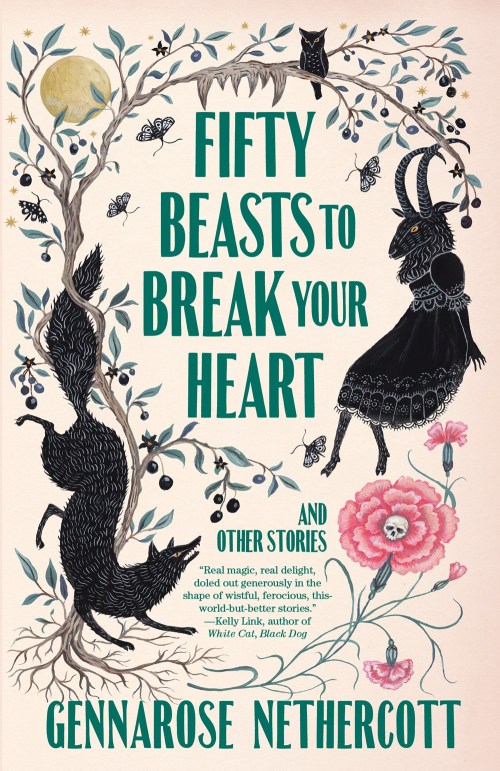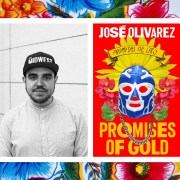[ad_1]
When I started reading GennaRose Nethercott’s short story collection Fifty Beasts to Break Your Heart: and Other Stories, I was struck by the evocative description that these stories were about “the abomination that resides within us all.” Nethercott’s characters yearn for something missing in their lives, often love—but also a purpose, an answer, or even revenge. But each story has a fantastical twist: a woman turning into a house; a medieval bestiary; teenage girls using the occult to deal with middle school life—to name a few.
This is Nethercott’s fifth book, following her astonishing 2022 novel Thistlefoot, and her book length poem The Lumberjack’s Dove, chosen by the late Louise Glück for the National Poetry Series. She’s part of the audio production team of Grim & Mild Entertainment, behind series like Lore and the newly released Harlots, where Nethercott is the host. She’s a multifaceted master storyteller, who draws on folktales and the otherworldly. I spoke to Nethercott about her recently released short story book.
This interview has been edited for clarity and length.

Elisa Shoenberger
What draws you to folktales?
GennaRose Nethercott
I think that people often assume that I’m a true believer of ghosts and goblins, but I’m really not so concerned with whether these stories are true or not. What I’m really fascinated by is what the stories that we tell say about us.
Folklore fulfills many different cultural and psychological needs. Some stories are told to warn your children not to go in the woods; some stories are told as ways of explaining scientific phenomena, or diseases [that] we don’t have explanations for.
My favorite categories of folktales are the ones where something is too painful or too taboo to talk about it directly. We’d rather come up with these incredibly fantastical, almost whimsical, metaphorical parallels. So by studying the folklore of a community, you can really get this fantastic window into what their fears are, what their taboos are, what their secrets are, and what things they refuse to look at directly—but draped in this strange fantasy. That’s really exciting to me. I’m drawn to folklore as a way to study people.
Elisa Shoenberger
Are monsters good or bad? Or does it depend?
GennaRose Nethercott
I think it absolutely depends on what story you’re telling and what metaphorical role the monster is playing. I think we have a real tendency today to make the monsters the good guys, which I think it’s an angle that hadn’t been done before. We want to do new things.
Monsters have so often been used as a tool for othering. Monstrosity originally was this way of describing people who had certain birth defects or deformities, like sideshow freaks. Monsters were people in our consciousness. But it was also a way of assigning a person a lack of humanity. I think it’s interesting to see a real reclamation of the title of monster. [It’s] something that someone who has been othered can take ownership over.
There’s a writer named Theodora Goss who has this awesome essay where she talks about how monsters contain contradictions and that’s what makes them monstrous. For Frankenstein’s monster or a vampire, they’re both living and dead. Werewolves are both animal and human. So they contain this contradiction. What makes us uncomfortable is the idea of “too muchness” contained within one body.
That’s something I think a lot about is: what are the dissonances within us that makes us monstrous or makes us feel monstrous? I don’t think it can be reduced to [designating] monsters as good or monsters bad. Like any folktale, they’re tools to say something and it depends on what that tool is being used for.
Elisa Shoenberger
What made you decide to use certain structures for your stories, like a bestiary for the titular story and an Abecedarian for “A Diviner’s Abecedarian?”
GennaRose Nethercott
I love restrictions in my writing practice. I love having to stick to a formula or a set of rules. It’s basically a problem that I’ve set for myself that I have to solve. With the bestiary, it was the ease of being able to sit down every day and have to create a creature. Then the through story was actually threaded into it later. Throughout it all, the creatures are kind of different manifestations of longing and symbols.
I just love the Latin bestiaries. They are a hoot. They were often allegorical, and they were descriptions of mostly real animals and some mythological ones. But with the real animals, the monks had never seen most of these animals that they were describing. So they made assumptions about them that were absolutely insane. [For example] they felt that hedgehogs had spikes so that they could roll around in a pile of grapes. Get a grape stuck to each spike and then take it home to their children. So every illustration of a hedgehog is just like covered in grapes. They’re so goofy and so fun.
With an abecedarian, it’s a traditionally poetic form, where each line starts with a new letter of the alphabet. I also love different means of divination. It was kind of this challenge of being like, “Okay, I have to find one for every single letter in a way that moves the story forward.” Honestly my brain works better that way. I’ve never thought of storytelling in sort of a linear way.
It’s kind of like turning a crystal over in your hand and looking at each facet of the crystal to get a complete story. That is so much more how I think of storytelling, which is why these fragmented forms really appeal to me. It’s like facets of a crystal, where each one is a different side and as you turn it over, you see all these different individual snapshots that form one cohesive tale, and leave the reader with a specific feeling.
Elisa Shoenberger
Could you talk about the first story in the collection “Sundown at the Eternal Staircase”?
GennaRose Nethercott
I think it’s fair to say that one of the reasons that I write in the genre that I do is because it allows me to talk about my actual life without feeling exposed. These stories are pretty emotionally autobiographical.
“Sundown at the Eternal Staircase” is one of my favorite stories, if not probably my favorite story in the book. That is very much about my home. I’m from Brattleboro, Vermont. It’s this small bucolic tourist town, where in the fall, it’s overrun by leaf peepers (people who are there to look at the foliage) from the city who come in to see the sights. But we also have one of the highest opiate overdose rates in the country.
I think you see this in so many tourist towns, the people in the town rely on that tourist income in order to financially survive. But in order to maintain that tourist income, they have to essentially abandon the most vulnerable members of the community in order to maintain this bucolic shiny postcard perfect reputation.
The story is really about addiction and a town that swallows people alive the way that mine does. I actually wrote that story when I was on tour with the Lumberjack book, where I was on the road for eight months solid. I converted the trunk of my Honda Fit into a little camper. I was in a new city every two days driving around the country.
At one point I was in New Mexico, driving back from a gig late at night, I saw there was a woman flying a sign on the side of the road. It was dark and it was cold. So she was all bundled up and couldn’t see her but I just knew that she was one of my best friends. I slammed on the breaks and put the car into reverse. I called out her name and she turned around and sure enough it was one of my closest friends from high school who we all lost track of more recently. She’d been an addict for a long time but I didn’t even know she was in New Mexico.
She hopped into the car and we chatted for a while. It was super sweet. She was just out on the streets in New Mexico, addicted to opiates. I gave her a hug and said goodbye and drove away and was really struck with this feeling that I didn’t know if I’d ever see her again. That’s when I wrote that story. I remember finishing the story and just being like, “Man, I really hope that I’m wrong that the story doesn’t end the way that I made the story end.”
She got clean, and came home, but then overdosed a year later. That was how the story ended in real life. I really wish I had been wrong.
This story is a very literal, personal kind of example of what’s at the heart of so many of these stories which are very literal experiences, memories, loves, connections, and losses.


FICTION
Fifty Beasts to Break Your Heart: and Other Stories
by GennaRose Nethercott
Vintage
Published February 6th, 2024
[ad_2]
Source link

